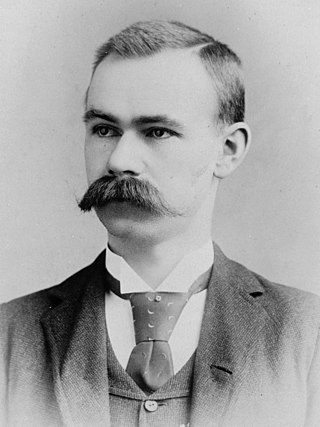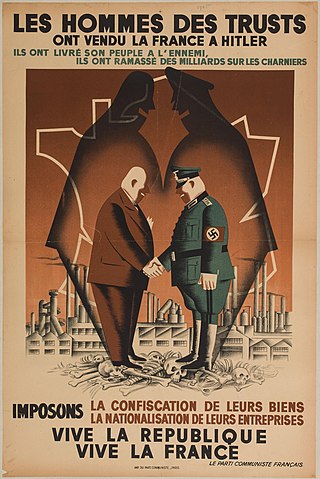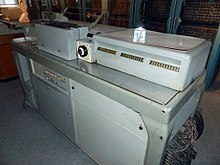
Herman Hollerith was an American statistician, inventor, and businessman who developed an electromechanical tabulating machine for punched cards to assist in summarizing information and, later, in accounting. His invention of the punched card tabulating machine, patented in 1884, marks the beginning of the era of mechanized binary code and semiautomatic data processing systems, and his concept dominated that landscape for nearly a century.

A punched card is a piece of card stock that stores digital data using punched holes. Punched cards were once common in data processing and the control of automated machines.

Thomas John Watson Sr. was an American businessman who was the chairman and CEO of IBM. He oversaw the company's growth into an international force from 1914 to 1956. Watson developed IBM's management style and corporate culture from John Henry Patterson's training at NCR. He turned the company into a highly effective selling organization, based largely on punched card tabulating machines. He authorized providing Hitler's Third Reich with data processing solutions and involved IBM in cooperation with Nazi Germany throughout the 1930s and until the end of World War II, profiting from both the German and American war efforts. A leading self-made industrialist, he was one of the richest men of his time when he died in 1956.
Electronic data processing (EDP) or business information processing can refer to the use of automated methods to process commercial data. Typically, this uses relatively simple, repetitive activities to process large volumes of similar information. For example: stock updates applied to an inventory, banking transactions applied to account and customer master files, booking and ticketing transactions to an airline's reservation system, billing for utility services. The modifier "electronic" or "automatic" was used with "data processing" (DP), especially c. 1960, to distinguish human clerical data processing from that done by computer.

The Powers Accounting Machine was an information processing device developed in the early 20th century for the U.S. Census Bureau. It was then produced and marketed by the Powers Accounting Machine Company, an information technology company founded by the machine's developer. The company thrived in the early 20th century as a producer of tabulating machines. It was a predecessor to the Unisys corporation.

Edwin Black is an American historian and author, as well as a syndicated columnist, investigative journalist, and weekly talk show host on The Edwin Black Show. He specializes in human rights, the historical interplay between economics and politics in the Middle East, petroleum policy, academic fraud, corporate criminality and abuse, and the financial underpinnings of Nazi Germany.

Starting at the end of the nineteenth century, well before the advent of electronic computers, data processing was performed using electromechanical machines collectively referred to as unit record equipment, electric accounting machines (EAM) or tabulating machines. Unit record machines came to be as ubiquitous in industry and government in the first two-thirds of the twentieth century as computers became in the last third. They allowed large volume, sophisticated data-processing tasks to be accomplished before electronic computers were invented and while they were still in their infancy. This data processing was accomplished by processing punched cards through various unit record machines in a carefully choreographed progression. This progression, or flow, from machine to machine was often planned and documented with detailed flowcharts that used standardized symbols for documents and the various machine functions. All but the earliest machines had high-speed mechanical feeders to process cards at rates from around 100 to 2,000 per minute, sensing punched holes with mechanical, electrical, or, later, optical sensors. The operation of many machines was directed by the use of a removable plugboard, control panel, or connection box. Initially all machines were manual or electromechanical. The first use of an electronic component was in 1937 when a photocell was used in a Social Security bill-feed machine. Electronic components were used on other machines beginning in the late 1940s.

A keypunch is a device for precisely punching holes into stiff paper cards at specific locations as determined by keys struck by a human operator. Other devices included here for that same function include the gang punch, the pantograph punch, and the stamp. The term was also used for similar machines used by humans to transcribe data onto punched tape media.

The tabulating machine was an electromechanical machine designed to assist in summarizing information stored on punched cards. Invented by Herman Hollerith, the machine was developed to help process data for the 1890 U.S. Census. Later models were widely used for business applications such as accounting and inventory control. It spawned a class of machines, known as unit record equipment, and the data processing industry.
The British Tabulating Machine Company (BTM) was a firm which manufactured and sold Hollerith unit record equipment and other data-processing equipment. During World War II, BTM constructed some 200 "bombes", machines used at Bletchley Park to break the German Enigma machine ciphers.

The Computing-Tabulating-Recording Company (CTR) was a holding company of manufacturers of record-keeping and measuring systems; it was subsequently known as IBM.
International Business Machines (IBM) is a multinational corporation specializing in computer technology and information technology consulting. Headquartered in Armonk, New York, the company originated from the amalgamation of various enterprises dedicated to automating routine business transactions, notably pioneering punched card-based data tabulating machines and time clocks. In 1911, these entities were unified under the umbrella of the Computing-Tabulating-Recording Company (CTR).

IBM and the Holocaust: The Strategic Alliance between Nazi Germany and America's Most Powerful Corporation is a book by investigative journalist and historian Edwin Black which documents the strategic technology services rendered by US-based multinational corporation International Business Machines (IBM) and its German and other European subsidiaries for the government of Adolf Hitler from the beginning of the Third Reich through to the last day of the regime, at the end of World War II when the US and Germany were at war with each other.
Both the United States and Nazi Germany used IBM punched card technology for some parts of their operations and record keeping.

René Carmille was a French military officer, civil servant under the Republic and Vichy government, and member of the French Resistance. During World War II, in his office at the government's Demographics Department, he created the National Statistics Service and the individual code number which would become the social security number after liberation and is still used in France today. While there, Carmille sabotaged the Nazi census of France, thus saving tens of thousands of Jewish people from death camps.

The International Business Machines Corporation, nicknamed Big Blue, is an American multinational technology company headquartered in Armonk, New York and present in over 175 countries. IBM is the largest industrial research organization in the world, with 19 research facilities across a dozen countries, having held the record for most annual U.S. patents generated by a business for 29 consecutive years from 1993 to 2021.
James Legrand Powers was a US inventor and entrepreneur, the founder of Powers Accounting Machine Company.

A number of international companies have been accused of having collaborated with Nazi Germany before their home countries' entry into World War II, though it has been debated whether the term "collaboration" is applicable to business dealings outside the context of overt war. Accused companies include Ford Motor Company, IT&T and Eastman-Kodak.















